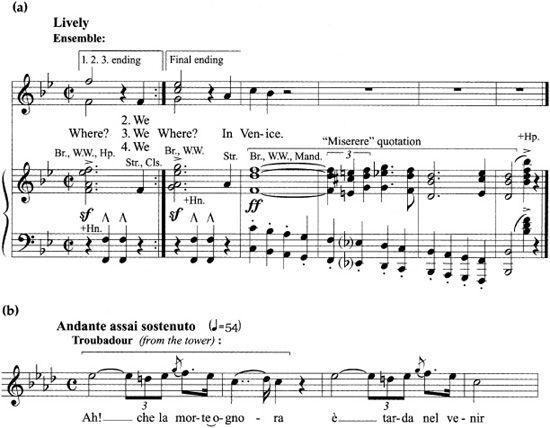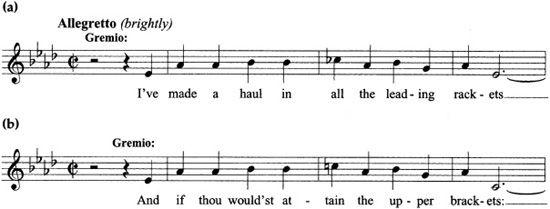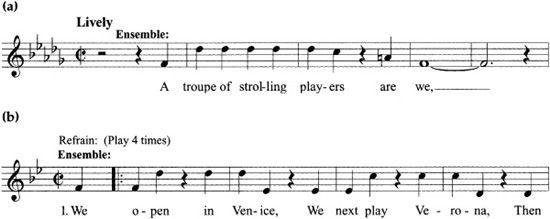Enchanted Evenings:The Broadway Musical from 'Show Boat' to Sondheim and Lloyd Webber (46 page)
Read Enchanted Evenings:The Broadway Musical from 'Show Boat' to Sondheim and Lloyd Webber Online
Authors: Geoffrey Block

I knew Cole had come through brilliantly. I knew what I had done and what Sam [co-librettist and spouse Samuel Spewack] had done was right. We had nothing to change. I knew it so I didn’t have to be superstitious. In the history of American musicals this is the only one where they didn’t have to touch a scene or a song. In rehearsals, changes were made. I wrote three versions, but I knew eventually we’d go back to the first one—and we did. There were disagreements over “Why Can’t You Behave?” and over “Bianca,” but the disagreements were all ironed out before we left town.
9
After four weeks to “rehearse and rehearse,”
Kiss Me, Kate
opened at the New Century Theatre on December 30, 1948, with nearly unequivocal endorsements from New York City reviewers.
When discussing the dramatic merits of
Anything Goes
(
chapter 3
) it was proposed that since Sir Evelyn Oakleigh does not sing, he does not deserve a woman like Reno Sweeney (Ethel Merman) who sings such hits as “I Get a Kick out of You,” “You’re the Top,” “Anything Goes,” and “Blow, Gabriel, Blow.” At the very least, Sir Evelyn’s non-singing status created a dramatic problem that future revivals tried to assuage. In
Kiss Me, Kate
the musically silent character does not get the girl. Fred Graham’s rival, the powerful Washington diplomat Harrison Howell who, like Sir Evelyn, remains songless, gets caught napping and ends up barefoot on Fred’s wedding day. Petruchio/Fred, who sings more songs than Kate/Lilli Vanessi, not only deserves to get a tamed Katherine at the end of the
Shrew
play, but he also gets a reformed spouse in real life.
It was also previously noted that Porter attempted to convey character musically in
Anything Goes
. Not only does Porter characterize his star Reno (Merman) with catchy syncopations and uncomplicated harmonies but he also conveys her spunky disregard for convention by having her sing triplets that clash with her duple meter, first and most consistently in “I Get a Kick Out of You” and later in “Blow, Gabriel, Blow.” Once he makes this association, Porter then demonstrates how Hope Harcourt becomes more like the star when she adopts Reno’s rhythmic signature in her own “Gypsy in Me.”
Not surprisingly, in the wake of Rodgers and Hammerstein’s
Oklahoma!
and
Carousel
Porter made a still greater effort in
Kiss Me, Kate
to channel music’s power to establish character. He does this most noticeably by distinguishing the
Shrew
players from the Baltimore players. The former are given musical characteristics loosely associated with music of the Italian Renaissance. Bianca and her suitors are given an a cappella pseudo-madrigal in “Tom, Dick or Harry,” the bluesy “Why Can’t You Behave?” is transformed into a Renaissance dance (the pavane), and several of the
Shrew
songs display the long-short-short figure (

 ) characteristic of the sixteenth-century Italian canzona.
) characteristic of the sixteenth-century Italian canzona.
10

Example 10.1.
“We Open in Venice” (closing orchestral tag) and “Miserere” from Verdi‘s
Il Trovatore
(act 4)
(a) “We Open in Venice” (closing orchestral tag)
(b) “Miserere” from Verdi‘s
Il Trovatore
(act 4)
Porter’s Italian evocations are not confined to the Renaissance. One nineteenth-century appropriation occurs in the orchestral tag to “We Open in Venice” (
Example 10.1
), where he quotes the opening of the “Miserere” from Verdi’s
Il Trovatore
(act 4). Perhaps Porter intended a musical pun (the “misery” of an endless road tour and its associations with Verdi’s fourteenth-century Spanish troubadour, Manrico) or perhaps he simply wanted to link a classic playwright with a classic Italian opera composer.
11
Porter adopts a more contemporary Italian flavor in “I Sing of Love” and “Where Is the Life That Late I Led?” and a more generalized Latin beguine character in “Were Thine That Special Face,” again to distinguish the
Shrew
numbers from the more recognizably American Baltimore numbers. Representative American vernacular characteristics include the show biz and jazzy quality of “Another Op’nin,’ Another Show,” the jazzy “Too Darn Hot,” the satire of Bowery waltzes in “Brush Up Your Shakespeare,” and the thirty-two-bar song form of a popularly styled ballad, “So in Love.”

Example 10.2.
“Tom, Dick or Harry”
(a) minor mode
(b) major mode
In his analysis of
Kiss Me, Kate
, Joseph P. Swain notes Porter’s technique of moving from the major mode to the minor mode or vice versa to distinguish the Padua songs from their Baltimore counterparts.
12
Indeed, with one exception (“I’m Ashamed That Women Are So Simple”) the texted songs sung in Padua juxtapose major and minor in dramatically purposeful ways. In “Tom, Dick or Harry” Porter distinguishes each suitor’s past accomplishments from their rosy description of Bianca’s future if she were to marry one of them by the simple juxtaposition of minor and major mode (
Example 10.2
). Similarly, Petruchio at the conclusion of “Were Thine That Special Face” moves from the minor to the major mode to capture the optimism of “then you’ll be mine, all mine” that concludes the song. In Petruchio’s “Where Is the Life That Late I Led?” Porter contrasts the life of the carefree bachelor in the main chorus (major mode) with a mixture of minor and major modes that conveys his bittersweet nostalgia for the women he must now relinquish as a married man. Thus, in the slower second portion of the song Momo and Rebecca stir memories in the minor mode and Alice and Lucretia in the major, while memories of Carolina and Fedora contain elements of the two.

Example 10.3.
“We Open in Venice”
(a) minor mode
(b) major mode
Porter lessens the dramatic contrast between Padua and Baltimore, however, when he contrasts major and minor modes in the latter songs as well. In fact, it might be said that this device—widely and effectively used by Schubert—not only serves as Porter’s way of demonstrating parallels between the
Shrew
numbers and the Baltimore numbers. In the end, it functions primarily as a unifying musical device that shapes a musically integrated score. The Paduan “We Open in Venice,” for example, was certainly intended to parallel “Another Op’nin,’ Another Show” in Baltimore. In the Padua excerpts (
Example 10.3
) the players sing in the minor mode when describing themselves and in the major mode when they relate their circular itinerary. Conversely, “Another Op’nin’” opens in the major mode (E major) and moves to G minor in the release (the B section) to convey the anxiety of the four weeks that lead to this opening (“Four weeks you
major) and moves to G minor in the release (the B section) to convey the anxiety of the four weeks that lead to this opening (“Four weeks you
rehearse
and
rehearse
/ Three weeks and it couldn’t be
worse
”). Even a song as far removed from the drama as “Too Darn Hot” demonstrates a prominent move from minor (the “too darn hot” portion) to major (the “Kinsey report” portion).
